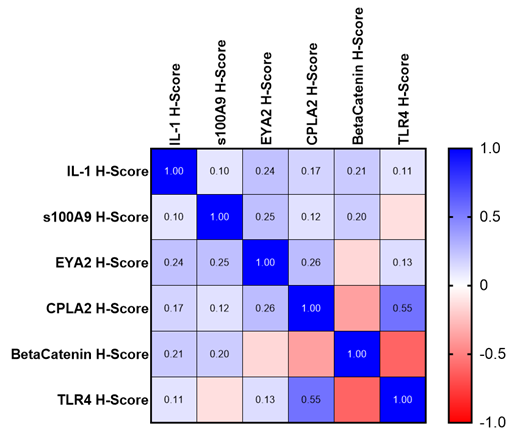Abstract
Background: Myelodysplastic syndromes (MDS) are characterized by aberrant maturation, ineffective hematopoiesis, cytopenias, and progression to acute myeloid leukemia. MDS pathogenesis is multifactorial and potentially linked to constitutive innate immune stimulation converging upon the NLRP3 inflammasome to induce pyroptosis, a caspase-1 dependent cell death. Inflammasome assembly is initiated by both cell-extrinsic stimuli including S100A9, the TLR4 and CD33 ligand, and cell-intrinsic danger signals licensing caspase-1 which activates IL1b and beta-catenin resulting in cell death and increased cellular proliferation leading to maturation and differentiation blocks. Further, EYA2 has been suggested to be an inflammasome activator, whereas PLA2 has been suggested to be an inhibitor. Recent work demonstrates immunohistochemistry (IHC) may be utilized to assess expression of inflammasome components. The purpose of the present study is to compare inflammasome component expression among patients with low and high risk MDS and correlate these findings with clinical outcome data.
Methods: An IRB protocol was approved prior to initiating this study. We retrospectively identified 87 patients with MDS including 40 (46%) low risk MDS and 47 (54%) high risk MDS patients. A tissue microarray (TMA) was constructed utilizing MDS bone marrow biopsy samples (2-3 representative cores per sample). IL-1, S100A9, EYA2, CPLA2, Beta Catenin, and TLR4 expression were assessed by IHC after validation of each antibody. IHC expression was scored independently by two hematopathologists by calculating scores (product of staining intensity x percent expression). IHC expression was compared using Spearman correlation estimate. Demographic and clinical data were collected and correlated with IHC expression using Kruskal-Wallis test, Spearman correlation, and Logrank test.
Results: Patients were median 72 years of age, 69% men and included 29% MDS-EB2, 28% MDS-MLD, 17% MDS-RS, 15% MDS-EB1, 9% MDS-SLD, 1% MDS del5q and 1% MDS/MPN-U. Correlation matrix in Figure 1 illustrates correlation seen between expression of various inflammasome components. Increased expression of CPLA2 and TLR4 (median 0.6 and 1.71, respectively) were observed in high risk MDS compared to low risk MDS (median 0.12 and 0.02, respectively, p<0.0001), and decreased beta-catenin expression was seen in high risk MDS compared to low risk MDS (median 0.00 vs 0.14, p<0.0001). IL-1, S100A9, and EYA2 expression was similar between high risk MDS and low risk MDS samples (median score 1.55 vs 1.55, 0.56 vs 0.60, and 0.74 vs 0.60, respectively). Simple linear regression demonstrates relationship between R-IPSS and CPLA2 (r 2=0.175, p<0.001), beta-catenin (r 2=-0.182, p<0.001), and TLR4 (r 2=0.555, p<0.001). Progression free survival (112.5 months vs 19.8 months) and overall survival (107.6 months vs 24.5 months) were longer for low risk MDS compared to high risk MDS, respectively (p<0.0001). Overall survival was increased in patients with low CPLA2 expression compared to high CPLA2 expression (88.9 months vs 38.1 months, p =0.0018), high beta-catenin expression compared to low beta-catenin expression (130.0 months vs 36.8 months, p < 0.0001) and low TLR4 expression compared to high TLR4 expression (90.1 months vs 22.3 months, p < 0.001).
Conclusions: IHC staining of inflammasome activators using TMA may allow better characterization of molecular pathways contributing the MDS pathogenesis. A correlation was seen between expression of antigens known to be increased downstream of NLRP3 inflammasome activation. Survival was increased in patients with low CPLA2 expression, high beta-catenin expression, and low TLR4 expression. Further characterization of inflammasome signaling may lead to novel therapeutic targets and prognostic tools in the management of MDS.
Lancet: Millenium Pharma/Takeda: Consultancy; Celgene/BMS: Consultancy; ElevateBio Management: Consultancy; BerGenBio: Consultancy; AbbVie: Consultancy; Daiichi Sankyo: Consultancy; Agios: Consultancy; Astellas: Consultancy; Jazz: Consultancy. Komrokji: Jazz: Consultancy, Speakers Bureau; AbbVie: Consultancy; Acceleron: Consultancy; Geron: Consultancy; Taiho Oncology: Membership on an entity's Board of Directors or advisory committees; PharmaEssentia: Membership on an entity's Board of Directors or advisory committees; Novartis: Consultancy, Honoraria, Membership on an entity's Board of Directors or advisory committees; BMSCelgene: Consultancy, Membership on an entity's Board of Directors or advisory committees, Speakers Bureau.


